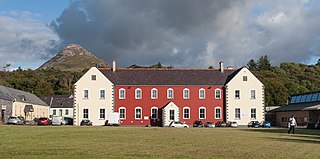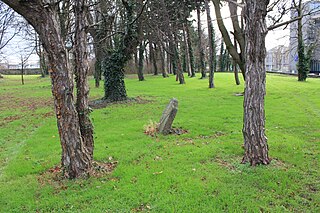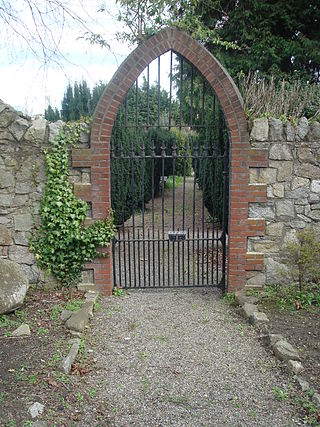
Drumcondra is a residential area and inner suburb on the Northside of Dublin, Ireland. It is administered by Dublin City Council. The River Tolka and the Royal Canal flow through the area.
The Ireland Yearly Meeting is the umbrella body for the Religious Society of Friends in Ireland. It is one of many Yearly Meetings (YM's) of Friends around the world.
The 2003 All-Ireland Senior Hurling Championship was the 117th since its establishment in 1887. The first matches of the season were played in May 2003, and the championship ended on 14 September 2003. Kilkenny went into the 2003 championship as defending champions, having won their twenty-seventh All-Ireland title the previous year.
A registration district in the United Kingdom is a type of administrative region which exists for the purpose of civil registration of births, marriages, and deaths and civil partnerships. It has also been used as the basis for the collation of census information.

Milltown Cemetery is a large cemetery in west Belfast, Northern Ireland. It lies within the townland of Ballymurphy, between Falls Road and the M1 motorway.
Town commissioners were elected local government bodies that existed in urban areas in Ireland from the 19th century until 2002. Larger towns with commissioners were converted to urban districts by the Local Government (Ireland) Act 1898, with the smaller commissions continuing to exist beyond partition in 1922. The idea was a standardisation of the improvement commissioners established in an ad-hoc manner for particular towns in Britain and Ireland in the eighteenth century. The last town commissioners in Northern Ireland were abolished in 1962. In the Republic of Ireland, the remaining commissions became town councils in 2002, and abolished in 2014.

Mount Jerome Cemetery & Crematorium is situated in Harold's Cross on the south side of Dublin, Ireland. Since its foundation in 1836, it has witnessed over 300,000 burials. Originally an exclusively Protestant cemetery, Roman Catholics have also been buried there since the 1920s.

Industrial schools were established in Ireland under the Industrial Schools (Ireland) Act 1868 to care for "neglected, orphaned and abandoned children". By 1884, there were 5,049 children in such institutions throughout the country. The act was superseded by the Children Act 1908.

The Ashbourne Cup is an Irish camogie tournament played each year to determine the national champion university or third level college. The Ashbourne Cup is the highest division in inter-collegiate camogie. The competition features many of the current stars of the game and is sometimes known as the 'Olympics of Camogie' because of the disproportionate number of All Star and All-Ireland elite level players who participate each year Since 1972 it has been administered by the Higher EducationArchived 31 May 2011 at the Wayback Machine committee of the Camogie Association. TU Dublin are the current champions, having won the Ashbourne cup in 2023.

St. Peter's Church was a former Church of Ireland parish church located in Aungier Street in Dublin, Ireland, where the Dublin YMCA building now stands. It was built on land that formerly belonged to the Whitefriars in Dublin. It served the largest Church of Ireland parish in Dublin.

Bully's Acre is a former public cemetery located near the Royal Hospital Kilmainham in Dublin, Ireland. It is 3.7 acres (1.5 ha) in extent.

Carrickbrennan Churchyard located on Carrickbrennan Road, Monkstown, County Dublin, Ireland is a graveyard that can still be seen today, but is no longer in use. It is notable as the burial place of many people who perished in local maritime disasters. The graveyard stands beside the grounds of Monkstown Park, former estate of Lord Ranelagh and latterly the historian Charles Haliday, now used as rugby pitches by CBC Monkstown Park.

Donnybrook Cemetery is located close to the River Dodder in Donnybrook, Dublin, Ireland. The cemetery was the location of an old Celtic church founded by Saint Broc and later a church dedicated to St. Mary. The site has been in use between 800 and 1880 with the exception of some burial rights.

The Cabbage Garden, also known as the Cabbage Patch, is a former burial ground in Dublin, Ireland. It is located off Upper Kevin Street in Dublin's south inner city. Used as a cemetery from 1666 until the 1890s, it is now laid-out as a public park.

Ballybough Cemetery is a Jewish cemetery in Ballybough, Dublin. Founded in 1718, it is Ireland's oldest Jewish cemetery.

Goldenbridge Cemetery is a Non-Denominational garden cemetery located in Inchicore, Dublin, Ireland.
The Religious Society of Friends (Quakers) have a long history in Ireland; their first recorded Meeting for Worship in Ireland was in 1654, at the home of William Edmundson, in Lurgan.